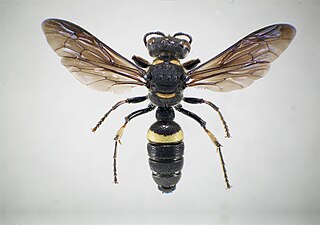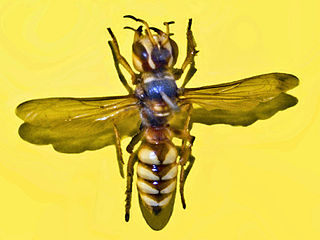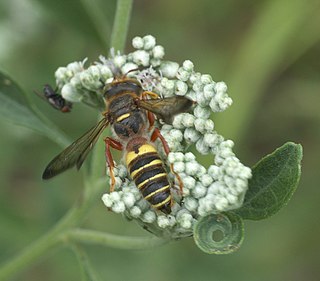
Arles is a coastal city and commune in the South of France, a subprefecture in the Bouches-du-Rhône department of the Provence-Alpes-Côte d'Azur region, in the former province of Provence.

A Roman circus was a large open-air venue used mainly for chariot races, although sometimes serving other purposes. It was similar to the ancient Greek hippodrome. Along with theatres and amphitheatres, circuses were one of the main entertainment venues at the time.

The Praetorian Prefecture of Gaul was one of four large prefectures into which the Late Roman Empire was divided.

Cerceris fumipennis, the only species of buprestid-hunting Philanthidae occurring in eastern North America, is found throughout the continental United States east of the Rockies: from Texas and Florida north to Maine, Wyoming, and into Canada. The wasps most often nest in open areas of hard-packed sandy soil surrounded by woody habitat suitable for their buprestid beetle prey.
The Battle of Arles was fought in 458 near Arelate (Arles) between Western Roman Emperor Majorian and Visigothic king Theodoric II. After the assassination of Flavius Aetius in 454, the Visigoths began to expand their kingdom at the expense of the crumbling Roman administration in Gaul and Hispania. When Majorian became emperor in 457, the Visigoths under king Theodoric II had just recently defeated the Suebic Kingdom in north-west Hispania and were consolidating their hold on the rest of the Iberian Peninsula.

Cerceris tuberculata is a species of wasp in the family Philanthidae.

Red Lodge Heath is a 20.8-hectare (51-acre) biological Site of Special Scientific Interest in Red Lodge in Suffolk.

Cerceris rybyensis, the ornate tailed digger wasp, is a Palearctic species of solitary wasp from the family Philanthidae which specialised in hunting small to medium-sized mining bees. It is the type species of the genus Cerceris and was named as Sphex rybyensis by Carl Linnaeus in 1771.
Cerceris atramontensis is a species of wasp in the family Philanthidae. It is found in North America.
Cerceris nigrescens is a species of wasp in the family Philanthidae. It is found in North America.
Cerceris tolteca is a species of wasp in the family Philanthidae. It is found in Central America.

Cerceris kennicottii is a species of wasp in the family Philanthidae. It is found in Central America and North America.
Cerceris rufopicta is a species of wasp in the family Philanthidae. It is found in North America.
Cerceris sextoides is a species of wasp in the family Philanthidae. It is found in Central America and North America.

Cerceris insolita is a species of wasp in the family Philanthidae. It is found in North America.
Cerceris californica is a species of wasp in the family Philanthidae. It is found in Central America and North America. This species is a predator of Buprestidae beetles.

Cerceris bicornuta is a species of wasp in the family Philanthidae. It is found in Central America and North America.
Cerceris frontata is a species of wasp in the family Philanthidae. It is found in North America.
Cerceris halone is a species of wasp in the family Philanthidae. It is found in Central America and North America. It is a known predator of Curculionidae beetles and nests in sand.









